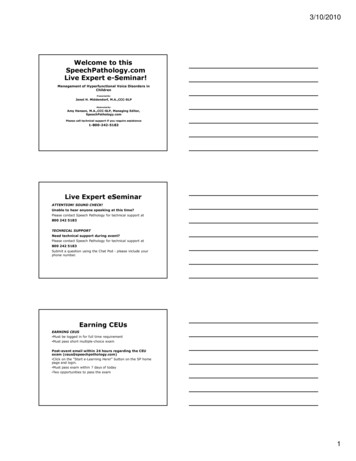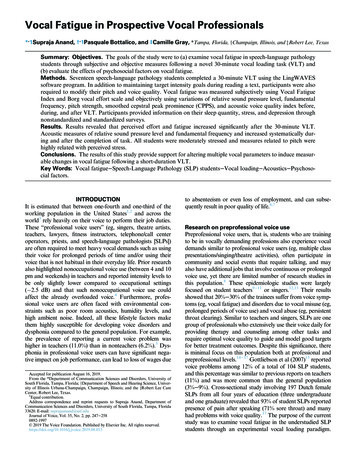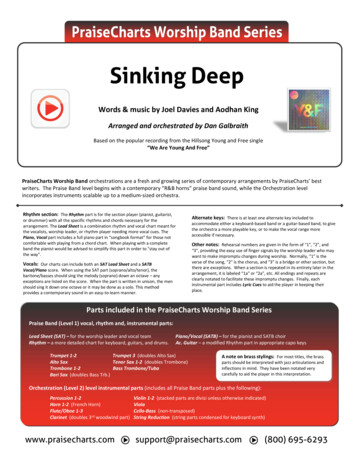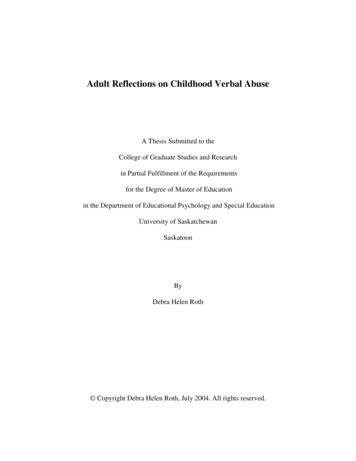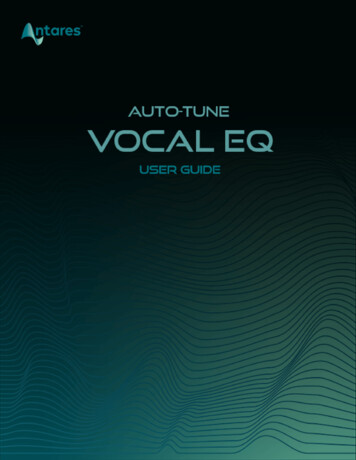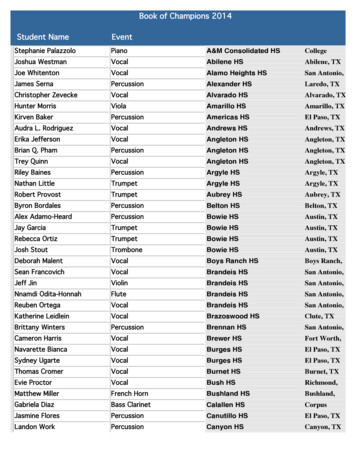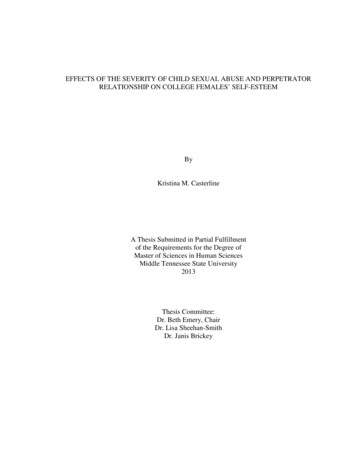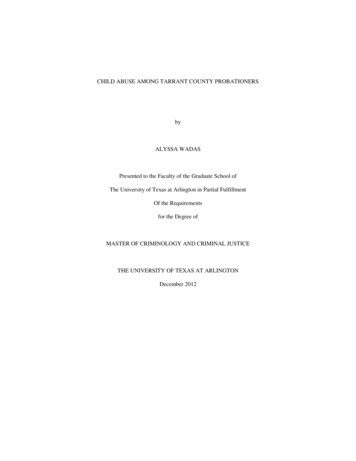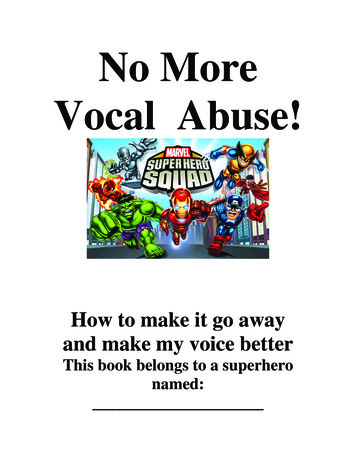
Transcription
No MoreVocal Abuse!How to make it go awayand make my voice betterThis book belongs to a superheronamed:
This will help me become a voice superhero.I will first learn about my voice, and then Iwill learn what I need to do to make it goback to normal. It is up to me to work hardand battle the things that are not good formy voice and do the things that will help myvoice.
I need to do good things with my voice andstay away from the bad things. If I don’ttake care of my voice, I can get nodules (thevillain). These are like the calluses I get onmy hands, but they are on my vocal folds.They can get angry and become red,swollen, and sore and feel like a sore throat.These nodules can make my voice rough,squeaky or scratchy. These nodules can evenmake it hard for me to talk.
Here are some pictures of what my vocal foldslook like normally and some pictures of what theylook like with nodules.Normal LarynxWhen I am breathing inWhen I am talkingVocal NodulesBreathing inTalking
QUESTIONS ABOUT MY VOICEWhat does my voice sound like to me?Do I like my own voice?Are there times when your voice sounds worse orbetter?Are there times when I yell and scream?
Bad things that can hurt myvoice.-YellingScreamingLoud cryingLoud singingClearing my throat and coughingMaking loud soundsDrinking sodas
Instead of YELLING andSCREAMING I can - Whistle- Wave my hands to my friends- Jump up and down . to get their attentionCan I think of other options thatare QUIET?1.2.3.
Sometimes I may feel like I want toyell because I’m mad or upset, butDON’T!Instead, I will try scribbling or hittinga pillow.Can I think of any other ideas?1.2.3.
Crying loudly is another kind of vocalabuse that hurts my vocal folds. If Iget hurt or I am sad or mad, I will tryto cry softly and not scream.
No loud singingSHHHH If I have to sing in a play at school, orin class or anywhere else, I willremember to sing very softly. Myteacher can help me remember I can also hum or just listen to music.
It hurts my vocal folds themost when I cough and clearmy throat I will swallow or get a drink of waterwhenever I need to cough or clear mythroat.
I will NOT make loud sounds like thesounds of trucks, cars, airplanes oranimals.Hmmmm .Can I think of other ways to makenoises without using my voice?1.2.3.
If I get sick and catch a cold or a sorethroat, I must .1. Get lots of rest and sleep.2. Drink lots and lots of water.3. Not talk unless I have to.And if I get laryngitis and lose mostof my voice, I must Not talk at all!
Remember to not scream or yellCount the times I yelled, screamed,talked over noise, made loud noises,cleared my throat .Dayof the SUN MON TUES WED THURS FRI SATweekWeek#1Week#2Week#3Week#4Week#5TOTAL
When I am playing gameswith friends and family,choose the quiet options!Count the times Dayof the SUN MON TUES WED THURS FRI SATweekWeek#1Week#2Week#3Week#4Week#5TOTAL
How much water, soda andother drinks did I have?Kind ofSUN MON TUES WED THURS FRI TAL
Vocal exercises I completed (Just-right voice, yawn-sigh)Day ofSUNMONTUES WEDTHUR FRItheweekWeek AM PM AM PM AM PM AM PM AM PM AM#1Week#2Week#3Week#4Week#5TOTALSATPMAMPM
DAILY JOURNAL ENTRIESTalk about how my overall vocal performance for each day was 1) Rate (positive) or – (negative).2) Problem areas3) Questions and concerns about the use of my urday
Your Child’s VoiceYour child can use his or her voice in healthy ways or in ways that can beharmful and result in problems. These problems most often occur duringspring season. This is the time for outside play and allergies; and team sportsare often a part of life. It’s natural for children to yell, cheer, shout and maketruck, plane and animal noises while playing. They may even excessivelycough or clear their throats because of summer colds. All of these behaviorscombined cause stress on the vocal folds, and as a result, vocal nodules maydevelop, which are callous-like growths. Nodules tend to interrupt goodvoicing and speech, which could be a problem in school. There are manythings that can be done to reduce the chance of, or eliminate, vocal nodules.The following is a home program that will help you and your child workwith the speech therapist to increase good voice habits.A typical vocal hygiene program will consist of:- Identifying the causes of the vocal problems;- Modifying behaviors that cause distress to the vocal folds; likeyelling;- Learning how to take deep breaths and relax the muscles in thethroat;- Taking time to speak slowly and clearly;- Staying properly hydrated throughout the day;- Avoiding caffeinated beverages, such as sodas, which do not hydratelike water does.
Some general tips that you as a parent can use at home:- Make a list of situations in which your child may misuse his or hervoice.- Become a careful listener (e.g., is there a lot of throat clearing athome or yelling at soccer practice?).- Remind your child to use a softer, gentler voice.- Develop signals to help your child remember to use an appropriatevoice (i.e., based on therapy suggestions).- Suggest alternatives to yelling at sporting events (e.g., noisemakers,signs, clapping).- Discourage the use of non-speech noises while playing (e.g. planesounds, beeping, car noises, etc.).- Turn down radio and TV volume when talking.- Suggest some quiet time activities, if your child is sounding hoarse.- Model good vocal behavior.We will be working on the three facilitating techniques in therapy,which your child will also be working on at home. These include thefollowing:1. Just right voice2. Chant talking3. Yawn-sighEvery day, your child should be quietly practicing these techniques in themorning and at night for a maximum of 10 minutes, so he or she doesn’t get
tired. These times should be referred to as “warm up” and “cool down”times, which will help the processes, become routine.Before beginning the techniques, it is important for your child to work onoverall relaxation of the body. Encourage your child to take a few breathsand relax from his head all the way down to the toes.1. Increasing loudness will involve working with the therapist to find hisbest pitch level. Then your child can practice this at home bysustaining vowel and eventually words and phrases.2. Chant talk is practiced by imitating chants such as monotone singing.Eventually moving towards reading and conversational speech.3. Yawn-sigh technique practice involves beginning to yawn and makingan easy “sigh” on the exhale. Once this is mastered, then openmouthed vowels and words that begin with /h/ will be introduced.Then they can move on to phrases and sentences. The following areexamples of words and sentences that can be used for practice.Yawn-sigh technique: H-Words of One hheardheedhardhihiltheelhashikehingeheat
h Technique: 6-Syllable Sentences1. Come to see our harvest.2. Jimmy’s heart can be fun.3. Harmless games can be fun.4. Play your harmonica.5. Sally hesitated.6. John is heading homeward.7. Can you catch his homerun?8. He hit Herman too hard.9. Hold his hammer for him.10.The food was horrible.
11.We enjoyed his houseboat.12.Hardly anyone left.13.A man is human too.14.Hike over this big hill.15.The cowboy yelled “howdy.”**You will also receive a child anti-vocal abuse booklet and chartpacket and journal. The book is for your child to read and learn abouthis or her voice and vocal behaviors that may cause vocal fold swellingand make the voice sound different. The charts are for your child tocomplete and ask for your help if needed. The charts allow your child tokeep tract and monitor vocal behaviors in hopes he or she will makehealthier voice production choices.
LSHSSClinical ForumQuick Screen for Voice andSupplementary Documents forIdentifying Pediatric Voice DisordersLinda LeeUniversity of Cincinnati, OHJoseph C. StempleBlaine Block Institute for Voice Analysis and Rehabilitation, Dayton, OHLeslie GlazeUniversity of Minnesota, MinneapolisLisa N. KelchnerUniversity of Cincinnati, OHVoice is the product of a combination ofphysiologic activities, including respiration,phonation, and resonance. A voice disorder ispresent when a person’s quality, pitch, and loudness differfrom those of a person’s of similar age, gender, culturalABSTRACT: Three documents are provided to help thespeech-language pathologist (SLP) identify children withvoice disorders and educate family members. The first isa quickly administered screening test that covers multipleaspects of voice, respiration, and resonance. It was testedon 3,000 children in kindergarten and first and fifthgrades, and on 47 preschoolers. The second document isa checklist of functional indicators of voice disorders thatcould be given to parents, teachers, or other caregiversto increase their attention to potential causes of voiceproblems and to provide the SLP with informationpertinent to identification. The final document is abrochure with basic information about voice disordersand the need for medical examination. It may be used tohelp the SLP educate parents, particularly about the needfor laryngeal examination for children who have beenidentified as having a voice problem.KEY WORDS: voice disorders, screening voice, voiceassessment, pediatric voice disorders308background, and geographic location, or when an individualindicates that his or her voice is not sufficient to meetdaily needs, even if it is not perceived as deviant by others(Colton & Casper, 1996; Stemple, Glaze, & Klaben, 2000).The incidence of voice disorders in children is oftenestimated at between 6% and 9% (Boyle, 2000; Hirschberget al., 1995). However, other sources identify ranges of 2%to 23% (Deal, McClain, & Sudderth, 1976; Silverman &Zimmer, 1975). In one study, 38% of elementary school-agedchildren were identified as having chronic hoarseness(Leeper, 1992). Unfortunately, it is estimated that the vastmajority of children with voice disorders are never seen by aspeech-language pathologist (SLP; Kahane & Mayo, 1989),and children with voice disorders only make up between 2%and 4% of an SLP’s caseload (Davis & Harris, 1992).Few studies have identified the type of laryngealpathologies that are most common to children. Dobres, Lee,Stemple, Kretschmer, and Kummer (1990) described theoccurrence of laryngeal pathologies and their distributionacross age, gender, and race in a pediatric sample. Datawere collected on 731 patients seeking evaluation ortreatment at a children’s hospital otolaryngology clinic. Themost frequent laryngeal pathologies were subglotticstenosis, vocal nodules, laryngomalacia, functional dysphonia, and vocal fold paralysis. For the total sample, theseLLANGUAGEANGUAGE, S,PEECHSPEECH, AND, ANDHEARINGHEARINGSERVICESSERVICESIN S CHOOLSIN S CHOOLS Vol. 35 308–319Vol. 35 October 308–3192004 AmericanOctober 04/3504–0308
pathologies were much more common in males than infemales, with the youngest patients (less than 6 years old)identified as having the most pathologies. The distributionof pathologies within the races sampled (Caucasian, AfricanAmerican, and Asian) was similar to that found throughoutthe total sample.Although it has been argued by some that treating voicedisorders in children is unnecessary or even potentiallyharmful (Batza, 1970; Sander, 1989), others have arguedfor the opposite opinion (Kahane & Mayo, 1989; Miller &Madison, 1984). Indeed, Andrews (1991) suggested thatunlike some other developmental disorders, maturationalone does not significantly affect vocal symptoms.Habitual patterns of poor voice use do not, as some havesuggested, disappear at puberty. In other words, children donot outgrow voice disorders.The identification and management of pediatric voicedisorders is important for the child’s educational andpsychosocial development, as well as physical and emotional health. The underlying cause of any dysphonia mustbe determined because voice disorders that share the samequality deviations may have vastly different behavioral,medical, or psychosocial etiologies (see review in Stempleet al., 2000).The majority of children with voice problems areidentified by individuals other than the school SLP (Davis& Harris, 1992). Typically, the teacher, nurse, or a familymember notices that a child has developed an abnormalvoice quality and makes the initial contact with the SLP.These referral sources lack training in making perceptualquality judgments, so they may miss more subtle problemsthat need professional attention. Depending on the task,teachers may or may not be accurate in identifying childrenwith voice deviations (see review in Davis & Harris, 1992),and many parents may assume that the child will outgrowthe disorder. Perceptual voice quality evaluation can bedifficult even for the SLP (Kreiman, Gerratt, Kempster,Erman, & Berke, 1993; Kreiman, Gerratt, Precoda, &Berke, 1992), so depending on untrained persons to identifythese children is less than ideal.One common method of identifying childhood communication disorders is through mass screening. Unfortunately,voice has received scant attention in most speech andlanguage screening tools. For example, the Fluharty-2Preschool Speech and Language Screening Test (Fluharty,2001) has one line for clinician response to voice quality(“sounded normal; recheck may be necessary”). Similarly,one line for description of the voice is allotted on theSpeech-Ease Screening Inventory (Pigott et al., 1985).These conventional one-line summaries fail to address thevoice comprehensively; that is, they do not assess the threesubsystems of respiration, phonation, and resonance. Voiceproblems are typically reduced to a generic description ofquality deviation and may easily be overlooked because ofsuch minimal opportunity for evaluation.Identification of children with voice disorders could befacilitated with several documents. A screening toolcovering multiple aspects of voice, respiration, and resonance could replace the more general voice evaluationstatements that are provided on current screening tools.Additionally, a checklist of functional indicators of voicedisorders in children and adolescents that could be given toparents, teachers, or other caregivers may increase theirattention to potential causes of voice problems and providethe SLP with information pertinent to identification. Finally,a brochure with basic information about voice disorders andthe need for medical examination may help the SLPeducate parents. These needs are addressed in the presentdocument.QUICK SCREEN FOR VOICEA screening tool entitled Quick Screen for Voice (seeAppendix A) was developed by the second author (JS). Itprovides more thorough delineation of tasks and measuresthan the more open-ended requests for observation of voicequality that are currently available on speech and languagescreening tests. The tool may be used for speakers of allages, from preschool through adult.Respiration, phonation, resonance, and vocal flexibilityare the hallmarks of healthy and acceptable voice production,and all are included in this test. These subsystems of voiceproduction are assessed separately. Lists of perceptualcharacteristics that are commonly associated with disordersof that subsystem are contained in each section. Definitionsof each perceptual characteristic are provided in Appendix B.The protocol is designed to be administered in 5 to 10min. Administration time is reduced when the child’s voiceis judged to be normal. When abnormal signs are found inany subsection, the test form provides appropriate languagefor vocal behaviors that the SLP may not observe oridentify without it. These identifiers can then be used whenreporting findings and generating individualized educationalplan (IEP) goals, if a management program is necessary.Directions and ScoringThe Quick Screen for Voice should be administered in aquiet area that is free of distractions. The tester should beseated close to the individual.Perceptual characteristics of the voice are judged bylistening to the individual speak. Therefore, the examinershould engage the individual in topics, such as family orfriends, hobbies or other interests, favorite holidays orvacations, favorite classes in school, and so on. To assistelicitation of spontaneous speech, the individual may beasked to tell a story about pictures that are sufficientlydetailed to allow a 2–3 min description or elicited sample.Recited passages, counting, or other natural samples ofcontinuous speech may also be used.The examiner responds to a checklist of observations thatare made during the spontaneous speech and other voicingtasks. The speaker fails the screening test if one or moredisorders in production are found in any section. In suchcases, the individual would be scheduled to be screenedagain, have a more comprehensive voice evaluation, or bereferred to a physician with a request that the child beexamined by an otolaryngologist or other specialist.Lee et al.: Quick Screen for Voice309
Field Tests and Subsequent RevisionsThe screening tool was used during two formal massspeech and language screenings with preschool and schoolage children, and more informally with adult graduatestudents taking a voice disorders class. The primary purposeof using the tool in these situations was to determine its easeand clarity of use, whether or not it contained complete listsof observations under each category, and confirmation of thecriterion for passing or failing.Screening of kindergarten and first and fifth gradestudents. The Quick Screen for Voice was used as part of acomprehensive speech, language, and hearing screening of3,000 elementary school children in 53 school districtsthroughout Ohio. Half of the children were in regularkindergarten and first grade; half were in fifth grade. Theschool districts were chosen because they represented a widevariety of urban, rural, and suburban locations; averagefamily income; percentage of minority population; anddistrict expenditure per pupil. Students receiving part-timespecial education services were included. Students receivingfull-time special education in segregated classes or separatebuildings were omitted from the sample. Seven universitydepartments participated. The screening tests were administered by trained graduate students under the supervision oflicensed and certified SLPs. The students practiced administering the tests before conducting the screening.The percentage of students failing the total screeningtest and each subcategory is contained in Table 1. Someindividuals who fail screening tests will be found by moreintensive diagnostic tests not to have a communicationdisorder (i.e., a false positive). Conversely, some studentswith a communication disorder may pass a screening,although the incidence of these false negatives is expectedto be low if examiners are trained and tests are properlyadministered. The actual number of false positives and falsenegatives resulting from the mass screening is not known.Therefore, the percentage of students failing the screeningwas adjusted by factors that would correct for both falsepositives and false negatives by using the Delphi technique(Linstone & Turoff, 1975; Rothwell & Kazanas, 1997;Woudenberg, 1991). This procedure involves a series ofsteps to elicit and refine the perspectives of a group ofpeople who are experts in the field. The first step wasselection of the panel (in this case, a group of individualsin academic and clinical settings with extensive knowledgeabout similar tests and their outcomes). The second stepwas to survey the panel members to obtain their predictionsof test outcome based on their knowledge about the currentliterature. The estimates were analyzed using descriptivestatistics such as mean and median. If the estimates wereclose to each other, the values were used. If the estimateswere not close, the results were cycled back to the panelmembers, who were asked to reconsider their answers.Respondents who were relatively far off from the averagefigures were asked to explain why they kept their originalresponse, if they decided to do so.False positives were calculated as a ratio of the numberof students without a voice disorder who were incorrectlyclassified as having failed the test, over the total number of310LANGUAGE, SPEECH,ANDHEARING SERVICESINTable 1. Results of administration of the Quick Screen forVoice to 3,000 students, half in kindergarten and first gradeand half in fifth grade. The total percentage failed, percentageby subcategories of the test, and percentage after Delphiadjustment are presented. Individual percentages do not addup to the total percentage because it is possible that a childcould have more than one item checked in each area.PercentagefailingAfterDelphiadjustmentfor falsepositivesAfter Delphiadjustmentfor falsepositives andfalse negativesGrades K and .015.3Grade .4students failing the test. False negatives were calculated asa ratio of the number of students with a voice disorder whowere incorrectly classified as having passed the test, overthe total number of students passing the test. Because theactual number of false positives and false negatives wasnot known, the numbers used in the ratios were based onexpert panel predictions. The panel first adjusted theobserved scores for false positives, and then made anadditional adjustment for both false positives and falsenegatives, combined. These percentages are contained inTable 1.The percentage of actual failures (34.5% for kindergarten and first grade; 20.9% for fifth grade) was higher thanmost previous reports in the literature (Boyle, 2000; Dealet al., 1976; Hirschberg et al., 1995; Silverman & Zimmer,1975). The percentage of children failing the present voicescreening was consistent with the results of the concurrentspeech and language screenings, which were also considered high (16.9%, 3.2%, and 1.2% of kindergarten and firstgraders, and 13.5%, 2.6%, and 1.1% of fifth graders failedlanguage, articulation, and fluency, respectively). Overall,39.2% of kindergarten and first graders and 29.5% of fifthgraders failed all language, articulation, fluency, voice, andhearing screening, even after Delphi adjustment for falsepositives.It should be noted that the highest percentages of failureson the Quick Screen for Voice were in the category of vocalrange and flexibility. On the version of the tool used in themass screening, habitual pitch, pitch inflection, loudnesseffectiveness, and loudness variability were based onclinician judgment of these parameters during conversationalspeech. The authors suspected that the failure rate on thissubtest may have been inflated because of difficulty withjudging these particular parameters during conversation,SCHOOLS Vol. 35 308–319 October 2004
especially because the parameters were not defined.Therefore, specific tasks to demonstrate pitch and loudnesswere substituted for the more subjective judgments.Habitual pitch and loudness are determined by having thechild count from 1 to 10, repeat, but stop at “three” andhold out the /i:/. A maximum phonation time (MPT) taskwas also added to this section. The changes in the tool maylower the percentage of failures on this subtest.Screening of preschool children. The second revision ofthe Quick Screen for Voice followed screening of 47children (25 boys; 22 girls; ages 3–6 years) in a Head Startprogram at Arlitt preschool in Cincinnati, Ohio. None ofthe children who participated in this screening had beenpreviously diagnosed with a voice disorder. Four trainedgraduate students completed the testing.Results revealed that 19% (9 out of 47) of the participants failed the initial screening. Six were boys; three weregirls. Subjects failed because of abnormalities in the areas ofrespiration (n 1), phonation (n 4), and resonance (n 4). No abnormalities were found in the category of nonverbal vocal range and flexibility. The 4 subjects who failed theinitial screening because of resonance disturbance passed thesecond screening. The examiners had noted signs of a coughand nasal congestion upon initial examination, and theseproblems apparently resolved before the second test. Theremaining 5 subjects retained the characteristics found on theinitial screening and failed the second screening.In order to determine intrajudge reliability, one examinergave the test a second time to 5 subjects who passed thescreening test and the 4 subjects who failed the phonationsection. The second test was administered a week followingthe first, and the results of the initial test were not available to her. Interjudge agreement was measured by havingtwo of the graduate students independently test 5 subjectswho failed any portion of the screening test and 6 subjectswho passed it. Both intrajudge reliability and interjudgeagreement were excellent (100% for each measure). Finally,all subjects who failed the initial screening were testedagain 5 months later. No intervention was provided betweenscreening tests. The 5 subjects who failed the secondscreening also failed the third.Final version of the tool. Clinicians participating inboth the preschool and school-age screenings providedfeedback to the authors about their experiences with thescreening tool. Suggestions for improving directions, easeof use, and lists of observations under each category wereincorporated into subsequent revisions, all of which wereconsidered minor. The clinicians agreed with the pass/failcriterion provided a second screening was considered forany child who demonstrated signs of illness, such ascongestion resulting from an upper respiratory infection.FUNCTIONAL INDICATORS OF VOICEDISORDERS IN CHILDRENAND ADOLESCENTSThe identification of children with voice disorders in theschools does not rely on annual screening of every child.Although policies differ across districts, the usual practiceis to screen only certain grades each year. Some evidenceexists that teachers can be a reliable referral source if theyare asked to make a gross dichotomous judgment (refer/donot refer) and if they are encouraged to overrefer if indoubt (Davis & Harris, 1992).The Functional Indicators Checklist (Appendix C) is aninformal probe that is designed to detect evidence ofconsistent voice differences that can represent a potentialvoice disorder resulting from underlying medical, voice use,or emotional factors. The checklist uses symptoms orsituational-based judgments that are identifiable to parents,teachers, and other caregivers of children and adolescents.The specific probe items are nonstandardized, and there isno critical number of positive signs that suggest a need forfurther referral. Rather, the “yes/no” format is intended tosummarize an inventory of impressions about the speaker’sability to use effective voice in the “real world.”The checklist items were derived from the authors’experience with common case history questions that areuseful in signaling a potential threat to voice quality. Theprobes are intended to “operationalize” specific judgmentsof voice production and quality. For example, rather thanquerying abstract constructs related to voice loudness orendurance, a representative functional indicator wasselected and was related directly to academic interference,which is a key qualification standard for service in theschools (e.g., “Can’t be heard easily in the classroom whenthere is background noise”). Because information is soughtabout vocal competence, as well as overall speaker confidence in the functional communicative environment, probeitems were included to assess the emotional impact ofvoice differences (e.g., “Doesn’t like the sound of his/herown voice” or “Is teased for the sound of his/her voice”).The Functional Indicator Checklist is a quick and easysupplement that may cross-validate the other Quick Screenjudgments made for voice production. For example, the item“Voice sounds worse after shouting, singing, or playingoutside” will provide the screener with information aboutvariability and potential voice use factors that may supportaudio-perceptual judgments of vocal instability. Although thechecklist is meant to be a supportive adjunct to the QuickScreen, it may also be used as a follow-up survey.Finally, the Functional Indicators Checklist can lendsupport to any future treatment plans if the real world tiesto communication needs are sufficiently meaningful tochildren and adults. A child may certainly not care aboutthe pitch, loudness, or quality of his or her vocal signal,but may respond more willingly to goals that are designedto create a voice that is loud enough to call a play on thebaseball field, or answer a question from the back of theclass, or doesn’t hurt or sound “scratchy” at the end of theday. These and other functional voice connections caninform the treatment process and provide direct applicationsto generalization and treatment outcome measures.YOUR CHILD’S VOICE“Your Child’s Voice” (see Appendix D) is a documentthat was developed to help SLPs educate the parent of aLee et al.: Quick Screen for Voice311
child who has been identified with a voice disorder. It wasdeveloped in response to comments to the authors by anumber of otolaryngologists that parents had only a vaguesense of why they were instructed to bring their child foreval
A typical vocal hygiene program will consist of: - Identifying the causes of the vocal problems; - Modifying behaviors that cause distress to the vocal folds; like yelling; - Learning how to take deep breaths and relax the muscles in the throat; - Taking time to speak slowly and clearly ;

